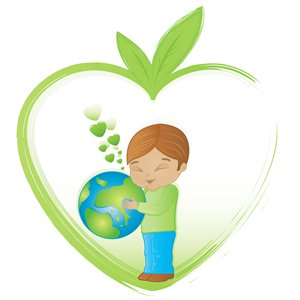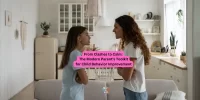Earth Day 2010! There are many little things that each of us can do to help the Earth. However, every day can, and should, be Earth Day. Try these activities and tips to help your family build a greener future.

Living Green Around the House
Table of Contents
- Plant a tree or grow a garden. Indoor plants act as natural filtration systems. In short, the indoor plants keep the air fresh and oxygenated. Keep them inside your home too to keep the inside fresh.
- Turn off the lights. CO2 is the main contributing factor to global warming. Every time you use something electronic, use electricity, fire up your car or even take a shower (you water has to be heated) you are emitting CO2. Turn off the lights, take shorter showers, turn down your hot water heater and don’t let your car idle for more than one minute.
- Stop using one-time-use plastic water bottles and microwavables. You can recycle your plastic water bottles and microwavables, but after being recycled several times, the plastic downgrades. Get reusable 5 gallon food safe plastic buckets and go with glass jars for storage.
- Unplug. Electronic devices still use energy, even when they are turned off. Unplug your radio, stereo, blow dryer and television to save more than 1,000 pounds of carbon dioxide. This amounts to around $256 a year.
- Turn off the water. By simply turning off the tap when you are washing the dishes or brushing your teeth, you can save as much as 2.4 gallons of water – per minute. I admit, I am bad about this one but am working on it! I brush my teeth with my kids and they are now helping to keep me stright 🙂
- Dispose of batteries, paint, bleach and nail polish the right way.
- Stop getting junk mail. Junk mail in your mail box can generate a lot of paper waste. Remove your name from lists on www.donotmail.org and get a paperless version of the yellow pages at www.yellowpagesgoesgreen.org.
- Go green with your laundry. Wash your clothes in cold water and hand them out to dry. You will save energy, cut down on CO2 and your clothes will last longer!
- Here is one I am guilty of. Do you have a cell phone? When you take it off the charger make sure you unplug the cord from the wall. The charger is still using draining and using electricity! I learned that at http://www.treehugger.com/files/2005/11/treehugger_home_2.php
- Try composting. You can start your own bin for around $20 or even less. You will prevent hundreds of pounds of waste (40% of which is food) from making it to the landfill. This is better because in a landfill, everything is compacted so most of the items do not biodegrade due to lack of oxygen.
- Create art for your walls. Use pictures of old calendars and magazines to make art for your walls or put fun appliqués on old tiles to make wall decorations.
- Use “green” cleaning products. You can use “green” household cleaning products, but they can be a little pricy. White vinegar, salt and lemon are items that you probably already have in your home, are not petro based and do a great job. Also, vinegar, applied with old newspapers work great for washing your mirrors and windows.
- Recycle! Recycle! Recycle! If you need some help disposing of heavy metal items, the scrap copper dealer Sydney trucks can pick it up for you as long you are in their area.
Living Green when Out and About
- Don’t litter. Discarded plastics, trash and even cigarette butts can wind up in our beaches and oceans. In case you were wondering, in the Pacific Ocean there is a patch of garbage plastic that is 300 feet deep and twice the size of Texas.
- Take public transportation. Taking the subway or city bus saves energy and you can relax while enjoying the ride.
- Ride your bike or walk. It is good for you and good for the environment.
- Shop at thrift stores. You can find great deals and you can help the environment by recycling clothing.
- Pay your bills online. You cut out the paper bills. Less paper means less waste. This equals to a healthier, cleaner environment!
- Freecycle! Visit www.freecycle.org and find your community in the list. Join and begin freecycling! You can get things that other people are getting rid of, and you can freecycle things that you no longer want. This reduces the amount of waste that winds up in the landfills and you can wind up with some really cool stuff.
Eating Green
- Eat local fruits and vegetables. On the average, vegetables and fruits have to travel more than 1500 miles to get to your grocery store. If you eat local produce you not only cut down on the energy that is required to grow and transport your food (by 1/5), you also support your local farmers.
- Buy organic, grass fed meat. In January 2008, the FDA approved cloned meat. There are no requirements that this meat be labeled or marked, so you have no way of knowing whether or not your meat is cloned unless you are buying organic.
- Read your labels. Just about 60% of the foods that you find on your grocery store shelves is genetically modified. Read the labels and look for hidden ingredients such as sugar and high fructose corn syrup. Basically, if you can’t pronounce it, you probably don’t want it in your body.
- Eat fresh. Frozen foods require ten times more energy to produce. They also offer less nutritional value than their fresh counterparts. What’s more, they are usually packed with preservatives. Fresh is best.
- Buy natural foods. Many brands are responding to their customers’ demands for natural foods and are introducing natural versions of old favorites. Smucker’s (www.smuckers.com) has a line of natural peanut butter and fruit preserves. Cascade Fresh (www.cascadefresh.com) has a line of natural yogurts with active cultures. Whole Foods brand 365 has many natural foods from salsa to chocolate to sodas. You will find the taste is better and there really isn’t that much of a difference pricewise from the less healthy versions.
There are many things that you and your family can do to live greener. Don’t try to do it all at once. Take baby steps, incorporate one or two practices at a time and eventually your family will be living green full time!












A green building is designed to conserve resources and reduce negative impacts on the environment – whether it is energy, water, building materials or land.
good one. Computer or your PC consumes more electricity than a laptop computer. Encourage employees use laptops in office and save up to 90% of energy.
More people should definitely ride bikes. It’s just unfortunate that drivers aren’t cautious enough around cyclists. I’m also really getting used to unplugging things!